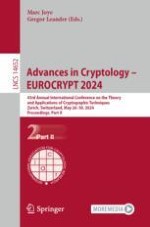2024 | OriginalPaper | Buchkapitel
Registered Functional Encryptions from Pairings
verfasst von : Ziqi Zhu, Jiangtao Li, Kai Zhang, Junqing Gong, Haifeng Qian
Erschienen in: Advances in Cryptology – EUROCRYPT 2024
Verlag: Springer Nature Switzerland
Aktivieren Sie unsere intelligente Suche, um passende Fachinhalte oder Patente zu finden.
Wählen Sie Textabschnitte aus um mit Künstlicher Intelligenz passenden Patente zu finden. powered by
Markieren Sie Textabschnitte, um KI-gestützt weitere passende Inhalte zu finden. powered by
Abstract
-
We build the first Reg-FE for linear function or inner-product evaluation (Reg-IPFE) from pairings. The scheme achieves adaptive IND-security under k-Lin assumption in the prime-order bilinear group. A minor modification yields the first Registered Inner-Product Encryption (Reg-IPE) scheme from k-Lin assumption. Prior work achieves the same security in the generic group model.
-
We build the first Reg-FE for quadratic function (Reg-QFE) from pairing. The scheme achieves very selective simulation-based security (SIM-security) under bilateral k-Lin assumption in the prime-order bilinear group. Here, “very selective” means that the adversary claims challenge messages, all quadratic functions to be registered and all corrupted users at the beginning.
